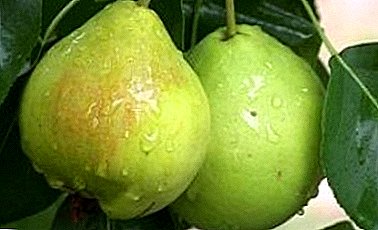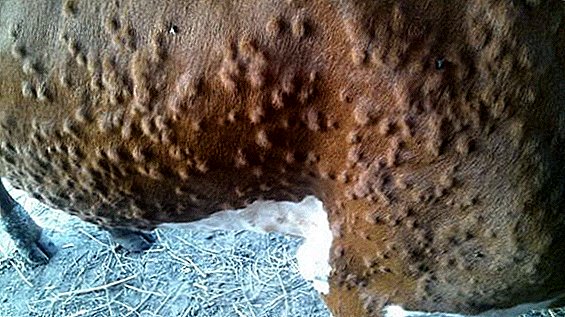 Cattle and suffer big when attacked by these small but surprisingly harmful creatures. Subcutaneous gadflies terrorize animals throughout the Northern Hemisphere, causing serious damage to livestock productivity. And although livestock breeders have already gained experience in effectively treating the consequences of this scourge, preventive measures, as always, prove to be more effective and cheaper. How this actual problem is solved, and will be discussed further.
Cattle and suffer big when attacked by these small but surprisingly harmful creatures. Subcutaneous gadflies terrorize animals throughout the Northern Hemisphere, causing serious damage to livestock productivity. And although livestock breeders have already gained experience in effectively treating the consequences of this scourge, preventive measures, as always, prove to be more effective and cheaper. How this actual problem is solved, and will be discussed further.
What is this disease
Hypodermatosis is a dangerous disease caused by hypodermic gadflies and affects cattle. The disease becomes chronic due to the long parasitization of the larvae in the body of animals. As a result, the vital organs of animals are injured and their productivity drops.
Did you know? A cow's nose imprint is as unique in the world of cattle as a fingerprint among people.
Pathogen, sources of infection
The disease is caused either by an ordinary subcutaneous gadfly, called a string, or by a southern subcutaneous gadfly, which is also called the esophagus. However, the direct pathogens of the disease are not the gadflies themselves, but their larvae that enter the organism of animals.  1 - female winged gadfly; 2 - eggs on the hair; 3 - exit from the larva egg; 4 - 1st stage larvae in the spinal canal; 5 - 3rd stage larva under the skin; 6 - pupa in the soil; 7 - adult male Females of gadflies, similar in appearance to bumblebees, lay about 800 eggs on the animal's hair in early spring. After five days, larvae up to three centimeters in length come out of them, which:
1 - female winged gadfly; 2 - eggs on the hair; 3 - exit from the larva egg; 4 - 1st stage larvae in the spinal canal; 5 - 3rd stage larva under the skin; 6 - pupa in the soil; 7 - adult male Females of gadflies, similar in appearance to bumblebees, lay about 800 eggs on the animal's hair in early spring. After five days, larvae up to three centimeters in length come out of them, which:
- At the first stage of their development, they penetrate into the body of an animal and within two or three months move towards the spinal cord.
- Moving to the second stage, the larvae settle in the lumen of the spinal canal. This stage for row larvae lasts up to three months. The larvae of the esophagus migrate toward the esophagus and penetrate its walls, where they parasitize for five months.
- After that, the larvae move to the back area, where they settle in the subcutaneous tissue and create capsules for transformation into third stage larvae after molting. This process takes from three to five months.
- Having matured, the larvae leave the body of the animal through the fistulas formed in their skin of a cow or a bull, fall to the ground and pupate there after digging.
Read about other diseases of cattle that are caused by parasites: cysticercosis, teliasiosis, anaplasmosis, babesiosis.
Symptoms
Cows and bulls, attacked with gadflies, when larvae penetrate into their bodies, display clear symptoms in the form of:
- restless behavior while on the pasture;
- swelling, itching, painful condition of individual skin areas;
- drastic weight loss;
- drops in milk yields;
- paralysis of limbs caused by parasitizing a large number of larvae in the spinal canal;
- formations in the area of the back or loin hardening with tiny holes;
- contamination of wool due to heavy discharge of pus from the nodule.

Diagnostics
Typically, hypodermatosis is diagnosed by simple visual inspection and palpation of the skin of cows and bulls during the period of migration of larvae to the skin of the back. When present, the tubercle with a small hole in the middle is easily detected. More easily detected nodule with fistula. In the south, this diagnosis is carried out at the end of December, and in more northern regions it is carried out at the end of February.
Important! Most often, this disease overtakes one to three-year-old cows and cattle, which feeds on defective food.
Pathological changes
 With the autopsy of an animal infected with hypodermatosis, one can observe:
With the autopsy of an animal infected with hypodermatosis, one can observe:
- small bubbles in the subcutaneous tissue, in which there are small larvae;
- on the paths of migration of pathogens - dark green stripes;
- when parasitizing the larvae in the esophagus on the affected areas - swelling and hemorrhage;
- on the skin and in the fiber under them - fistulous capsules.
Did you know? A cow for its average twenty years of life is capable of producing approximately 200 thousand glasses of milk.
Methods of struggle and treatment
Traditionally, in identifying symptoms in cattle that indicate hypodermatosis, active measures are taken in two stages:
- From mid-September to November, when nodules are found on the back of the cattle, it is treated with chlorophos. Along the ridge of a cow or a bull, a special dispenser means is distributed by a thin stream.
- During the second stage from March to September, the destruction of the larvae that are in the second or third stage of development is carried out. To this end, 10 g of 4% chlorophos are diluted in a liter of water, and the resulting solution is applied to the affected skin sites with a dispenser.
Check out the common diseases of cows.
The remedy for hyperdermatosis, which is so popular today, has proven itself very well. "Hypodectin-N". Influencing the larvae in a systemic and contact way, the drug causes the death of parasites. To this end, in the fall after the cessation of the flight of gadflies and in the spring, when fistula capsules of animals are found on the backs of a cattle, this preparation is treated with a small stream along the spine at the rate of 5 ml for cattle weighing less than 200 kg and 10 ml - weighing over 200 kg.
To this end, in the fall after the cessation of the flight of gadflies and in the spring, when fistula capsules of animals are found on the backs of a cattle, this preparation is treated with a small stream along the spine at the rate of 5 ml for cattle weighing less than 200 kg and 10 ml - weighing over 200 kg.
Important! Do not use "Hypodectin-N" when wet skin of animals and you can not expel cattle under the rain earlier than four hours after treatment with the medicine.
Preventive measures
With such costly due to losses in the productivity of sick animals and long-term treatment of hyperdermatosis, preventive measures are being put in the forefront to prevent this scourge from occurring. To do this:
- To carry out preventive work at all stages of the operation of the herd.
- Graze cattle mainly in the morning and evening with reduced activity of gadfly.
- In the regions where there is a high risk of infection with this disease, to carry out preventive treatment of livestock with the help of pyrethroid agents and chlorophos monthly, without missing a single animal.
- Subcutaneously inject cattle means "Aversect" to scare off pathogens.
- Handle with biothermal stalls.
- Disinfect manure.
- In the warm season, every 20 days, treat the livestock with Butox, Stomazan, K-Otrin or Ectomin.
 This disease, which takes a lot of energy and nerves from livestock breeders and causes significant damage to farms, is not immediately detected and not soon treated, therefore it is much more advantageous not to allow it at all, taking simple but effective preventive measures.
This disease, which takes a lot of energy and nerves from livestock breeders and causes significant damage to farms, is not immediately detected and not soon treated, therefore it is much more advantageous not to allow it at all, taking simple but effective preventive measures.












